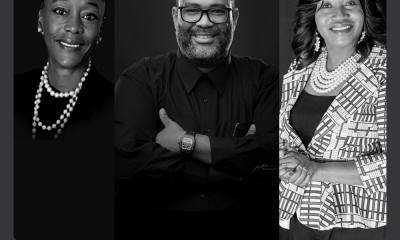Legal Business
Law Firms: Any Vision For Your Practices?

The age-old dispute whether Law is a noble profession or a business has been long laid to rest. Law firms are set up for the practice of law and to render legal services, just as hospitals are set up to render medical services. However highlighting the importance of the administrative and business aspects of the law profession does not diminish its nobility. There is the professional aspects and the business aspects of the law. Only a well-run business can be an efficient and successful professional firm. Law is both a noble profession and a multi Dollar business.
The Financial reports (2018 gross revenue) of a few law firms sufficiently attest to this fact -Kirkland & Ellis USD 3.76 billion, Latham & Watkins USD 3.39 billion, Baker & McKenzie USD 2.9 billion; DLA Piper USD 2.84 billion, Dentons USD 2.42 billion. Wachtell, Lipton, Rosen & Katzs’ turnover in 2018 -USD 763 million; $6.530,000 in profits per equity partner. Kirkland & Ellis profits per partner $5,037,000; Latham & Watkins $3,452,000, DLA Piper$1,757,000
The sizes and corporate structures of these firms also underscore the importance of the business and administrative aspects of law practice. In the UK despite the uncertainties of Brexit and the much touted impending recession, The Lawyer (a UK based legal research magazine) – reported that well-managed law firms continue to thrive in their practices and benefit from new opportunities in the UK. The research magazine published the 2019 gross revenue of 200 top UK law firms – DLA Piper was at the top of the list with a revenue of £1.946 billion, followed by Clifford Chance £1.693billion, Linklaters £1.628billion, Allen & Overy £1.627 billion, etc.
Coming home to Nigeria, though we are bereft of statistics on law firm, the financial value of a few reported legal transactions sufficiently proves that law is both a profession and a business.
The Business of Law
From the business of law perspective, a law firm is made up of a group of people working together to deliver legal services for profit. A law firm is a vehicle formed to earn profits that will increase the wealth of its owners, all stakeholders and the community in which it operates. A law firm is an organized effort or activities by lawyers working togther to provide legal solution with the intention of building a going concern, an enduring entity.
From the business of law perspective, a law firm is a professional service that must be taken to the market (consumers); therefore it is subject to the market forces of supply and demand. Consequently sound technical knowledge alone – howbeit in Latin and English (Certiorari, Ad litem, Habeas corpus etc.), legalese, wig and gown, the gavel, and other sacred ornaments of the legal profession alone does guarantee the success of a law firm.
A Law firm should be run on sound business skills, knowledge and practices to ensure its financial sustainability. No law firm can survive and thrive without the combination of multi-disciplinary skills and professionals – which the changing aspects of law practice today demands.
Front or Backend?
Every business has a frontend and a backend. Law is no exception. There is the professional aspects and the business aspects of the law practice. The professional aspects – constitutes the frontend and the business aspects constitutes the backend. Is the frontend of a business more important than its backend? Can the backend be overlooked or compromised without consequences? In business, the quality of the backend heavily impacts the frontend.
What constitutes the backend of a law firm? The “messy little details” like Human resources – people or talent management, recruitment, retention, training and development, welfare, compensation, performance management, career progression and development, succession planning. Office Acquisition, facilities management, space planning and ergonomics.
Strategy – visioning, policy formulation, goal setting, mission and objective. Procurement, Logistics, operations, file management. Library and knowledge management.
Business/client development – value proposition, branding, website, social media, market collateral – brochures and newsletters.
Finance – budgeting, profit drivers, pricing, fee setting, billing and collection, cashflow management, tax, insurance, cost control and internal audit.
Governance and structure. Information technology – Practice support systems; Computer hardware and software systems, Electronic privacy issues, Disaster management and Business Continuity Processes, Document and Knowledge Management Systems, Artificial Intelligence, disruptive innovation like the commoditsation of legal services Etc.
The Balancing Act
Many law firms struggle with balancing the professional and business aspects of running their practice.Law practice have some inherent peculiarities that may pose as road-blocks to running a successful business. For instance, law firms are usually populated with very intelligent, opinionated and individualistic professionals. Independence is highly prized by lawyers. This is not a bad thing in itself but it can make governance a nightmare. Also, law firms can have highly politicised internal structures and decisions are usually consensus driven, which again, can make governance a nightmare. After “all said and done,” nothing is usually done because lawyers can have a particular strong aversion to taking directions–and management and administration is usually about directing, planning, innovating. Law firms can be individual client focused, with power usually based on client/revenue generation which is dangerous for firm cohesion. Another threat to law firm cohesion is the argumentative, competitive. Adversarial and even sometimes combative tendencies of lawyers.
Further, law firms usually are short-term focussed, bottom-line focussed and with poor investment mindset. In addition, it has been observed that lawyers are usually risk adverse.Another peculiarity is that most law firms have few role boundaries. It is typical to find lawyers in firms who wants to be the accountant, admin manager and human resources manager at the same time. Even some partnerships do not have and respect clearly defined roles. Unclear roles is the recipe for confusion in business. Importantly, running a successful business requires a lot of creativity and nimbleness. Law firms however are usually bound by precedents, are conservative, intolerant of mistakes – are trained to detect mistakes, impatient and pressurized because of deadlines. All these stifles creativity which is essential for business sustainability.
From the Back Office
From the Back Office will be focused on Law as a business. My name is Joy Harrison-Abiola, I have spent 21 years at the backend of law offices and have made some very interesting observations. Also, through the years, I have had the privilege of interacting with non lawyer (some lawyers) colleagues both in Nigeria and abroad who like me have spent years at the backend of law offices. These very seasoned business support professionals have shared their frustrations, observations and war stories that have helped in my journey. So I will be showing on this page what constitutes the back office of a law firm and how it can be effectively harnessed to make a law firm successful and sustainable.
The Trouble with Vision
A few years ago, I visited the back office of the 11th largest law firm in Boston USA – Burns & Levinson at the invitation of its CEO. I spent a couple of days and had the privilege of sitting down with one of its founders and of course my question was about Vision. What inspired the setting up of the firm in 1960? The “old man” gave me some very interesting perspectives on how they have navigated the very rocky American law business terrain for 50 years holding unto their vision. What is vision? Is there a relationship between vision and law practice? Does a vision drive a law firm or not? Is vision essential to the survival of a law firm? Who gets the vision? Is it essential that the vision is written and documented somewhere for easy reference? Who drives the vision? How is a vision communicated? Is it possible for a law firm to operate without a vision?
What is the vision of your law firm? Where is your law firm going? How far do you want to take your law firm? What will the destination look like? How will you know when you get there? A vision is an inspirational and aspirational destination on the horizon. The trouble with vision is that it is the thing lawyers typically omit to do when opening their law practice. Law firms ignore to articulate a vision for their firm. You find vision in very few law firm websites or marketing collaterals.
Meanwhile, Vision, if well crafted contributes to your brand – it has a way of carving out an identity for a firm – what it does, what it wants to become and what it believes in. Another trouble with vision I have observed from the back office is that even when a law firm articulates a vision, the vision is not translated to a shared corporate vision. Most lawyers lack the skill or the will to do this.
Why is vision, mission, values and a strategy document vital in business? The short answer is that without these, there is no direction, or there are several directions and confusion and wastage of resources follows. A good vision articulate’s the firm’s ultimate goals and objectives in a way that inspires and moves the firm in a specific direction. Any law firm that ignores this will do so at its detriment. A law firm that is serious about growth and success will pay attention to corporate visioning.

Article By: Joy Harrison-Abiola, a leading legal management professional and the Practice Administrator of Adepetun Caxton-Martins Agbor & Segun- ACAS-Law
Legal Business
Morenike George-Taylor: The fundamental term to include when raising investment

Morenike George Taylor, Founder Reni Legal Consulting | County Support Consulting (Image: Supplied)
I remember a pivotal moment in my career that taught me a profound lesson about the importance of securing sufficient funding for a project. It all started when my team and I were working on an ambitious venture, a hotel to be located in Lekki, a high brow area in Nigeria. After months of planning, I found an investor who was excited about the potential. He assured me that he would provide the necessary funds to bring our vision to life.
Initially, the investor invested a portion of the money, which gave my team and I a glimmer of hope. With that commitment, I felt a surge of confidence. We began allocating resources, hiring a team, and setting timelines. Everything seemed aligned for success.
However, as we progressed, the promises began to wane. The investor started delaying further payments, citing various reasons that ranged from market fluctuations to unforeseen personal issues. Each time I reached out for updates, I was met with assurances that the funds would come through soon. Then, midway through the project, the investor informed me that he could no longer fund the project.
This sudden withdrawal created a domino effect. We had already committed to other businesses that were relying on our funding to get started. As the primary business was still in development, those secondary businesses began to pressure me for repayments. They had their own obligations, and without the promised funds, they found themselves in a precarious position. It was an overwhelming situation, and I watched helplessly as relationships soured and trust evaporated.
The main business, which had so much promise, struggled to survive. Without the necessary capital, we couldn’t complete our operations or deliver our product to market. As the financial strain mounted, it became clear that our venture was on the brink of collapse. Ultimately, the business we had worked so hard to build didn’t make it.
This experience was a harsh but invaluable lesson. It underscored the critical importance of raising sufficient funding before embarking on any ambitious project and how this needs to be taken into consideration in any contract documentation you sign. If I had tied all our contracts and obligations to the complete funds being raised, we could have safeguarded our operations against such unforeseen circumstances.
This experience taught me that in business, clarity and preparation are paramount. Without sufficient funding, dreams can quickly turn into nightmares, and projects that hold so much promise can fade away before they even have a chance to succeed
In the world of business, securing adequate funding is crucial for success. Particularly, if you require $1,000,000 for example to execute your vision, it is essential to raise that exact amount and tie all your contracts to this figure, especially concerning repayment terms. This approach ensures that your business can commence operations without financial strain.
When you set out to raise capital, clearly defining your financial needs is the first step. If you determine that your project requires $1,000,000, raising exactly that amount helps avoid unnecessary complications. Insufficient funding can lead to a cascade of operational issues, including delays, inability to meet contractual obligations, and ultimately, project failure. By securing the full amount, you create a solid foundation for your business operations.
Tying your contracts to the $1,000,000 funding goal is a strategic move. This means that all agreements—whether with investors, lenders, or partners—should explicitly state that the commencement of business activities, as well as repayment obligations, are contingent on successfully raising this amount. If the funding goal is not achieved, the repayment terms should reflect that the business cannot commence. This protects you and your stakeholders from the risks associated with undercapitalization.
By ensuring that all agreements explicitly stated that the project’s commencement and the repayment terms hinged on successfully raising that target amount, we would have mitigated the risks of undercapitalization. It became clear to me that having a well-structured funding strategy is not just a financial necessity; it’s essential for operational stability and long-term success.
Now, I always emphasize to entrepreneurs the importance of securing the full amount required before diving into a project. A well-capitalized venture is not just better positioned to navigate challenges; it can seize opportunities and grow sustainably.
About the author:
Morenike is an award winning business strategist and the founder of Reni Legal Consulting and County Support Consulting. She operates as a business consultant across various sectors, leveraging her extensive expertise to provide strategic insights and tailored solutions. With a keen understanding of the complexities of different industries, she helps organizations navigate challenges and seize opportunities for growth.
As a qualified lawyer, Morenike combines her legal knowledge with a strong foundation in data management, agile methodologies, and risk management. She is a certified Data Management Professional, a Disciplined Agile Scrum Master, and a Risk Management Professional. This diverse skill set allows her to approach each consulting engagement with a comprehensive perspective, driving operational efficiency and fostering organizational success.
Legal Business
African Union, Google and Africa Practice launch Policy Framework to Transform Africa’s Startup Ecosystem

In a groundbreaking move to drive innovation and entrepreneurship across Africa, the African Union and its partners, including Google and Africa Practice, have launched the AU Startup Policy Framework and Model Law. The Policy Framework and Model Law articulate principles, recommendations, and policy innovations to tackle the challenges hindering startups in Africa. It provides specific sample clauses to guide African Union Member States in developing or updating their national startup legislative and regulatory governance arrangements.
The Policy Framework and Model Law, developed in cooperation with Google in line with its Memorandum of Understanding with the African Union Commission, is set to harmonise approaches to enabling startups and innovation, in line with the African Union’s broader harmonisation objectives.
Speaking during the launch held during the African Union 6th Mid-Year Coordination Meeting that brings together the African Union, the Regional Economic Communities, the Regional Mechanisms and the African Union Member States, H.E. Albert M. Muchanga, African Union Commissioner for Economic Development, Trade, Tourism, Industry and Minerals, said, “We are excited about the new prospects for our continent unlocked by the adoption of the Startup Policy Framework and Model Law which is set to leapfrog the startup ecosystem in Africa. As you know, small and medium-sized enterprises, including startups, represent most businesses in all sectors and are the primary source of job creation. Specifically, startups spur development by creating jobs in the digital economy, employing 34,000 people across the continent. Unfortunately, out of 1000 unicorns globally, only seven are in Africa. This is primarily due to complex regulations, limited funding, a scarcity of skilled labour, and fragmented markets in Africa. Therefore, the framework is expected to unlock some of these hurdles and set a strong foundation for the growth of Africa’s startup landscape, projected to expand to USD 10 billion by 2056.”
H.E. Albert M. Muchanga went on to highlight that “Africa is a young continent, by 2050, the continent will account for 25% of the global population. Governments need to make the provisions to enable capital flow for the burgeoning ideas coming out of Africa. We need to create an environment that enables these innovative minds to catapult the continent to economic prosperity, and this framework is what enables this.”
Google’s Regional Director, Sub Saharan Africa, Government Affairs & Public Policy, Charles Murito, noted, “Africa receives a disproportionately small share of global venture funding. In 2023, the continent raised a total of USD 4.5 billion from 545 disclosed venture capital deals, reflecting a 30% decrease in value and a 31% decline in the number of deals compared to 2022. Notably, 16% of the funding recipients were female-led ventures, only marginally up from 11% in 2020. Funding flows also skew towards the same sectors, exacerbating the financing challenge; with fintech continuing to lead deal volumes. The same destinations also receive disproportionately more of the financing flows into the continent: startups in Nigeria, Kenya, South Africa, and Egypt received 62% of the total deal volume.”
While there’s no universal formula for fostering innovation and startups, the framework outlines principles derived from successful models. It is a call to action to ensure that startups — particularly those led by women and youth can be better supported. This Policy Framework and Model Law holds the potential to address gender disproportionality in financing flows, inspiring a new wave of innovation and growth.
Marie Wilke, the Chief Innovation Officer at consulting firm Africa Practice, said, “The adoption of the Startup Policy Framework and Model Law marks the beginning of an exciting but potentially transformative phase. We must maintain momentum behind engagements with regional economic communities (RECs), regional organisations (ROs), and member states, to update and enact regional legal frameworks and national laws. Innovation is as much about finance and people as it is about drive. The future of Africa’s small and new businesses depends on our joint and decisive efforts to support them, paving the way for The Africa We Want.”
Legal Business
The Legal Lore: Taking us from the bench to the fireside

Photo Credits: Tonkin Clacey Inc
In the complex and intricate world of law, where every case is a story waiting to be told, the wisdom passed down from seasoned legal professionals holds immeasurable value. Within the hallowed halls of law firms and legal institutions, an age-old tradition persists-one that transcends formal training and case law. It’s the tradition of fireside chats, where senior legal practitioners weave narratives of their experiences, trials, and triumphs, igniting the flames of inspiration in the hearts of their junior counterparts.
In these intimate gatherings, the rigid walls of hierarchy crumble, and the barriers between senior and junior practitioners’ dissolve. Here, amidst the flickering glow of the fire, stories untold-stories of courtroom battles won and lost, negotiations that sealed deals or unraveled, and ethical dilemmas faced with unwavering resolve. Through these stories, senior legal practitioners impart not just legal knowledge but invaluable lessons from the trenches of practice.
For junior practitioners, these fireside chats serve as a beacon of guidance, illuminating the path ahead with the collective wisdom of those who’ve walked it before. They chats provide insights that textbooks can’t convey, painting a vivid picture of the complexities and nuances of legal practice. From navigating tricky client interactions to finding creative solutions to legal challenges, the stories shared in these informal gatherings offer a treasure trove of practical advice.
Moreover, fireside chats help to build a sense of fellowship and community within the legal profession. They create spaces where junior practitioners feel seen, heard, and valued—not just as legal novices, but as aspiring storytellers in their own right. Through the exchange of anecdotes and experiences, bonds are forged, mentorship relationships blossom, and a culture of continuous learning thrives.
Most importantly, these chats have the power to shape the trajectory of junior practitioners’ careers. By exposing them to diverse perspectives and real-world scenarios, these informal gatherings expand their horizons, instilling in them the confidence to navigate the complexities of the legal landscape. They inspire them to dream bigger, reach higher, and aspire to leave their own indelible mark on the legal profession.

Photo Credits: Baker McKenzie
In a profession where the stakes are high, and the journey is fraught with challenges, storytelling becomes a guiding light—a compass that points towards excellence, integrity, and justice. The Advancing Women in the Workplace (AWW) program- a program to support women in leadership in South Africa adopted this approach of storytelling as a model. So, let us gather around, dear practitioners, and share our stories. For in the flicker of the flames lies the power to shape not just individual careers, but the future of the legal profession itself.

Acknowledgements
The AWW program, a program sponsored by Vance Centre in partnership with the South African Legal Fellows Network and the US mission.
Written by: Adaobi Adaobi Egboka and Dr Kim Lamont-Mbawuli. Africa Program Director, Cyrus R. Vance Center for International Justice, Vance Center Consultant and Director of KLM attorneys.
-

 Afripreneur12 hours ago
Afripreneur12 hours agoRedefining Real Estate Marketing: An Interview with Imelda Usoro Olaoye, Founder of Thinkmint
-

 Afripreneur11 hours ago
Afripreneur11 hours agoOluchi Anoruo on building SmartPharm and addressing access to healthcare products
-

 Economy16 hours ago
Economy16 hours agoMeta Hosts its First Youth Summit in Nigeria to Drive Innovation and Empowerment
-

 Technology16 hours ago
Technology16 hours agoLG’s Brand Reinvention: A Global Success Story













